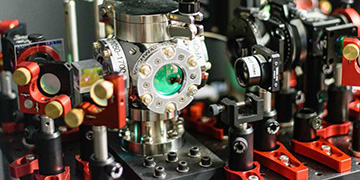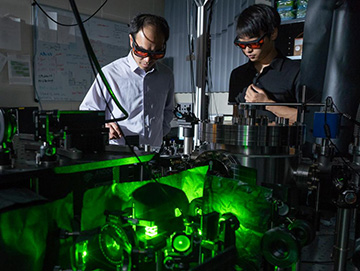![]()
Experiments at ETH Zurich, Switzerland, and Purdue University, USA, trapped nanoparticles in the waist of an optical tweezers setup, and rotated them at GHz frequencies using the spin angular momentum associated with circularly polarized laser light. This image depicts the “nanodumbbell” particles used in the Purdue experiment. [Image: Purdue University/Janghoon Ahn]
In a remarkable set of experiments, two separate research groups, in Switzerland and the United States, have used optical tweezers and circularly polarized light to spin individual nanoparticles at rates greater than 1 GHz—60 billion revolutions per minute (Phys. Rev. Lett., doi: 10.1103/PhysRevLett.121.033602, 10.1103/PhysRevLett.121.033603). The results, which blast through previous rotational-speed records by two orders of magnitude, could offer a testbed for studying the limits of materials under extreme conditions, and even for probing aspects of the quantum vacuum and quantum gravity.
Levitated optomechanics
In principle, rotating a nanoparticle at high speed is a problem in levitated optomechanics. To do the experiment, you trap a nanoparticle in an optical trap or optical tweezers, and hold the particle suspended in a near-vacuum. Then, with the particle levitated, you switch the trapping laser’s polarization from linear to circular. Transfer of the circular polarization, or spin angular momentum, from the light to the nanoparticle causes the particle to spin around the laser trap’s axis. By measuring changes in scattered light from the trap with a photodetector, you can get a reading on the particle’s rotational speed in the trap.
While the experiment is straightforward to describe, it’s devilishly difficult to execute, with a number of potential land mines that can scotch the drive toward high rotation speeds. One is the quality of the vacuum: even a relatively small number of air molecules can impose frictional drag that slows down the particle spin. Another is laser heating of the particle itself, which can cause it to slip out of the trap. Those pitfalls have limited previous measurements of spinning laser-trapped particles to rotational frequencies of no more than around 10 MHz.
Spinning silica nanoparticles

Vacuum apparatus used in ETH Zurich experiment. [Image: ETH Zurich/Michael Doderer]
To get around these obstacles, the ETH Zurich team of OSA Fellow Lukas Novotny made a number of improvements to the experimental setup. One was simply a much better vacuum; the researchers cranked down the pressure in the vacuum chamber to below 10–5 mbar—100 million times lower than normal atmospheric pressure. And they tweaked the wavelength of the trapping (and driving) laser to minimize the laser-heating effects.
Using the setup, Novotny’s team levitated and spun silica nanoparticles roughly 100 nm in diameter. The group was able to measure particle rotations with frequencies on the order of 1.31 GHz, more than two orders of magnitude above previous records. “It probably turned even faster,” lead author René Reimann, a postdoc in Novotny’s lab, noted in a press release, “but with our current photodetector we can’t measure any higher frequencies.” Novotny’s team was also able to measure the difference in attainable speed with variations in vacuum strength and laser power; both came in well aligned with model calculations.
In addition to basic studies in quantum optomechanics, the team believes the result could open a number of interesting research path. One, surprisingly, is in cosmology. It has been suggested, the paper notes, that rapidly spinning interstellar dust particles could be responsible for some of the GHz radiation measured in the cosmic microwave background; spinning up nanoparticles in their apparatus could allow tests of that hypothesis. Further, the authors observe that spins at the high rates apparently enabled by their setup create radial accelerations approaching the gravitational acceleration on the surface of neutron stars—which offers an opportunity to test the limits of material properties at the nanoscale.
Rotating “nanodumbells”

Purdue team leader Tongcang Li (left) and first author Jonghoon Ahn in the lab. [Image: Purdue University/Vincent Walter]
The other research group, led by OSA member Tongcang Li at Purdue University, used a setup very similar to that of Novotny’s team, but with an interesting variation. Instead of rotating quasi-spherical silica nanoparticles, they fashioned “nanodumbbells” roughly 320 nm in length, consisting of two silica nanospheres effectively joined at the hip. After trapping the nanodumbbell in the waist of the optical tweezers, the team was able to spin this levitated nanorotor at frequencies of 1.1 to 1.6 GHz.
In addition to offering tests of nanomaterials at extreme conditions, the Li team noted that the nanoparticle’s dumbbell geometry affords some interesting opportunities for exotic quantum studies. Effectively, the authors note, the levitated nanodumbbell constitutes “a novel analog of the Cavendish torsion balance,” which played a role in determining Earth’s gravitational constant and density distribution. Similarly, the team believes that the optically levitated nanodumbbell balance could be used to test gravity’s quantum nature, and to measure the Casimir torque—a frictional effect induced by fluctuations in the quantum vacuum itself.
